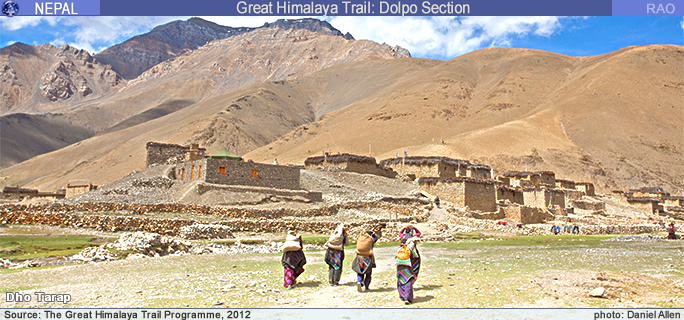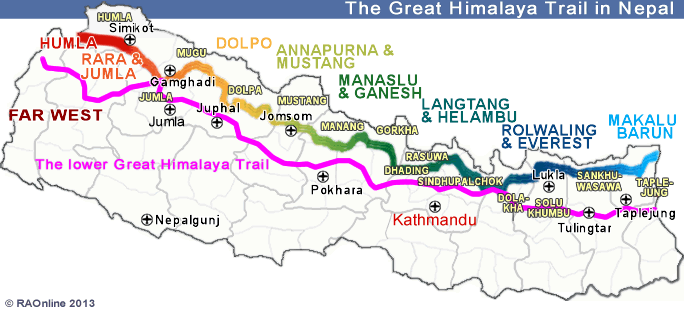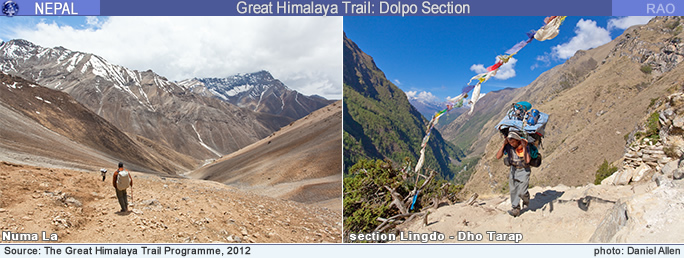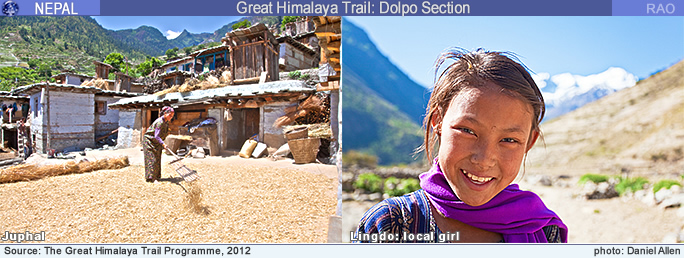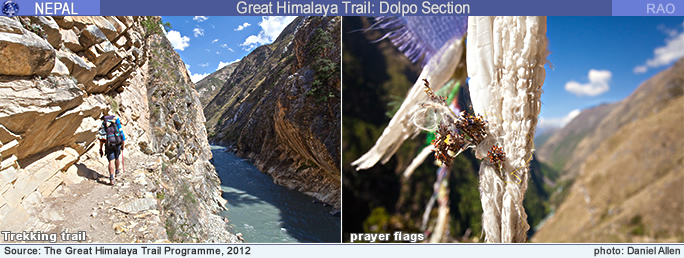 |
Nepal Trekkings |
|
 |
Nepal Trekkings |
|
|
 |
| Great Himalaya Trail - Dolpo Section |
The Great Himalaya Trail in Nepal
The new long-distance walking trail links established treks in the Annapurna and Everest regions with exciting new trekking destinations in Nepal's high mountains
The Great Himalaya Trail (GHT) is one of the longest and highest trekking trails in the world. The 1,700-kilometre route connects popular treks in the Annapurna and Everest regions with exciting new trekking destinations in the West and East of Nepal. Walking along the GHT, tourists can now cross the complete Himalayan range in Nepal, exploring remote and fascinating travel destinations, each featuring a unique blend of spectacular scenery and long-preserved cultures.
The GHT starts in the district of Taplejung in Nepal's East and ends in Humla and Darchula in the Far West of the country, close to the Indian and Chinese borders.
Trekkers can choose between two routes. The GHT main trail is winding through Nepal's high Mountain ranges on an average altitude of 4000 to 5000 metres, providing for breath-taking views on Nepal's towering peaks. The lower, cultural route visits some of the most remote mountain communities on earth. Here, tourists can learn about the everyday lives of the local people and gain insights to the traditions and rites of the various ethnic groups.
Nepal's GHT is divided into ten connecting treks of 2-3 weeks length, that can be done subsequently or completely separate from each other.
Besides, each GHT section features a number of side-treks of varying duration and difficulty, some of which require camping equipment and others that can be done teahouse style. With numerous trekking options and new tourism attractions, each GHT section forms a distinct trekking and adventure destination within itself. Crossing of the complete Himalayan range in Nepal along the GHT takes an average of 150 days.
| Dolpo Section |
 |
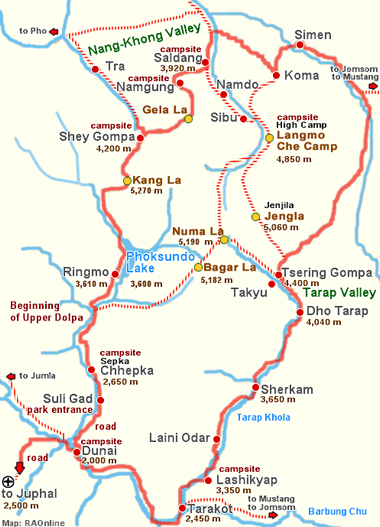 |
• Dolpa is a district of Nepal, Dolpo is the isolated, culturally Tibetan region to the North of it.
• People from ancient Juphal speak a language spoken only in two other villages.
• Overlooking the Phoksundo
Lake is the Pal Sentan Thasoon Chholing Gompa, a Bönpo Gompa said to have been built 60 generations ago.
Inner Dolpo is one of the last vestiges of authentic Tibetanculture. It's a land of ancient trading routes, monasteries and medieval fortresses set in a timeless landscape that is very distant from the modern world.
While Tibetan Buddhism is prevalent, the Bön religion of Tibet, which pre-dates Buddhism, is still practiced in just two villages, Ringmo and Vijer.
This mix of spirituality is visible everywhere - from the pilgrims on the trail to the sacred Crystal Mountain, to the many monasteries where monks carefully depict stories in intricate Thangkan paintings, to the animistic wooden dolls (dokpas) placed on bridges and roofs tasked with keeping evil spirits at bay.
|
|
The sight is really breathtaking. You can sit
there for hours, gazing at the lake and enjoying the serene surroundings.
The good part about the lake is that it is still free from any pollution
and any filth. There is no ugly littering around.
The lamas of the Shey
Monastery have forbidden anyone from having any bath (holy or otherwise)
or washing their clothes.
Here, in Inner Dolpo, lies Shey Gompa and Dho Tarap, some of the highest permanently inhabited villages on earth, reached only over high passes which, when snow-covered, leave Inner Dolpo isolated for many months of the year. The inhabitants are semi-nomadic, and trade forms a necessary part of their existence, as depicted in Eric Valli's beautiful film Himalaya. The stunning combination of arid slopes backed by endless snowy peaks requires a certain amount of quiet contemplation.
After such arid countryside, the stunning Phoksundo Lake seems like a miracle. Unusually clear, turquoise waters are bound by rocky cliffs traversed by frightening trails. From the right viewpoint, this picture is perfectly framed by snow-capped peaks. This is a must-see place- pictures won't do it justice.
The GHT section that crosses Dolpa mixes unique culture and an amazing diversity of nature with tough terrain that has challenged generations of nomads before you. It's certainly one of the more difficult sections, but perhaps the most rewarding.
| Source: The Great Himalaya Trail Development Programme, March 2012 |
 |
| Trekkings in Nepal |
 |
| more information on Nepal |
 |
| Links |
 |
 |
 |
External
links |
|

